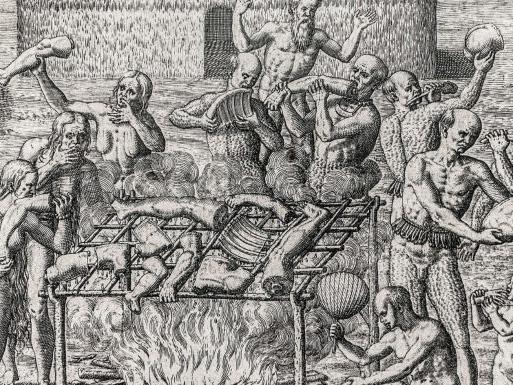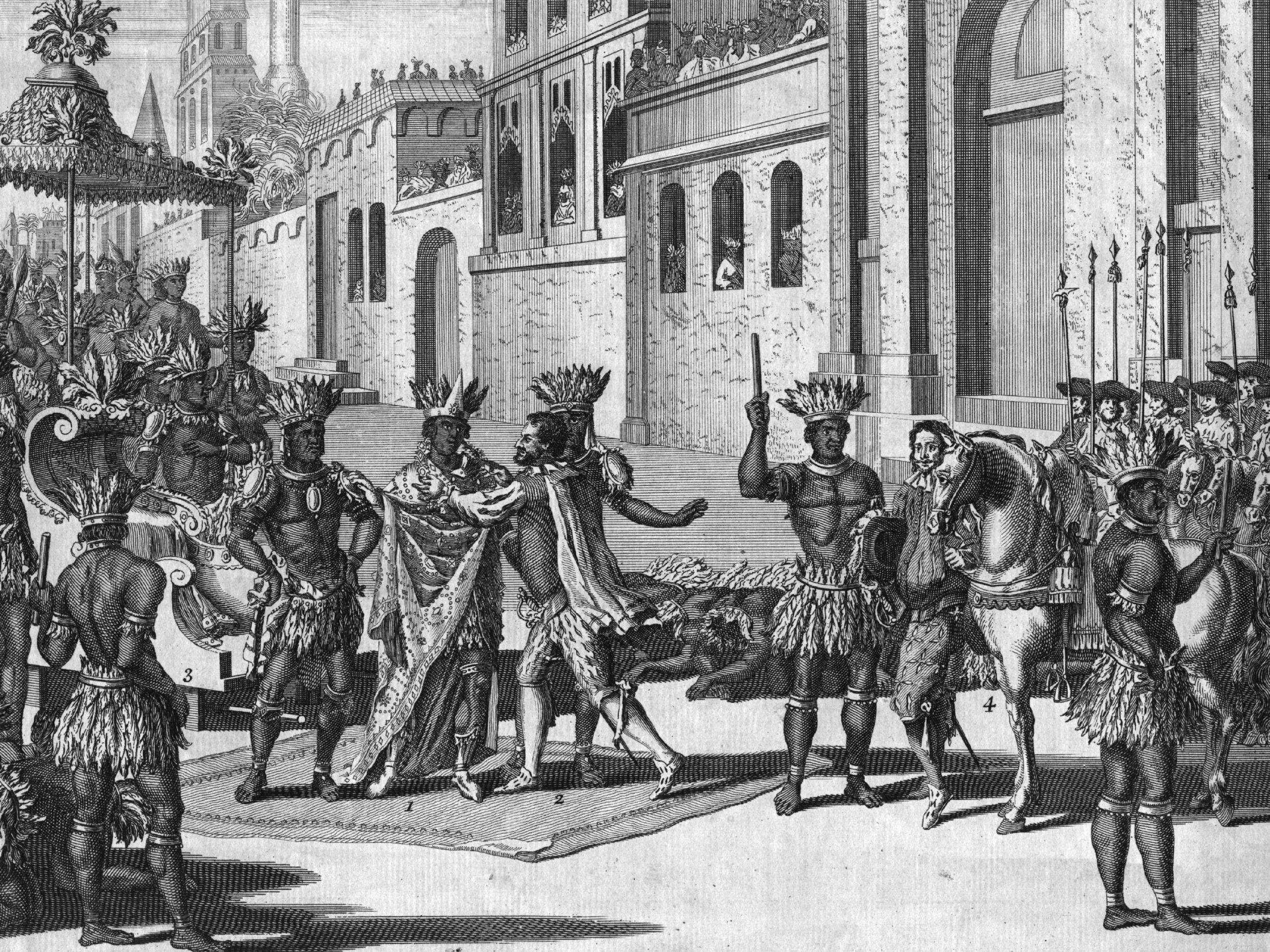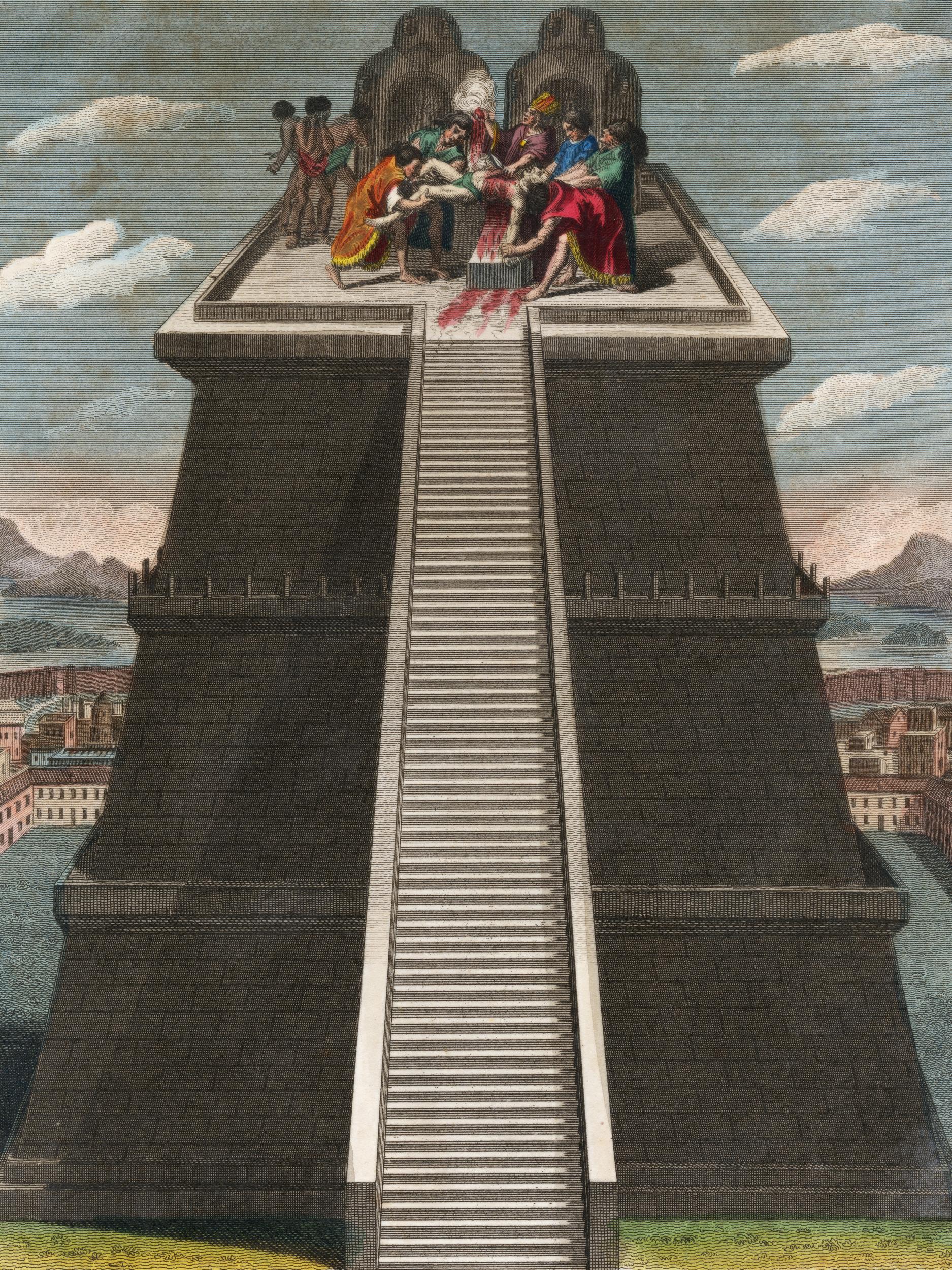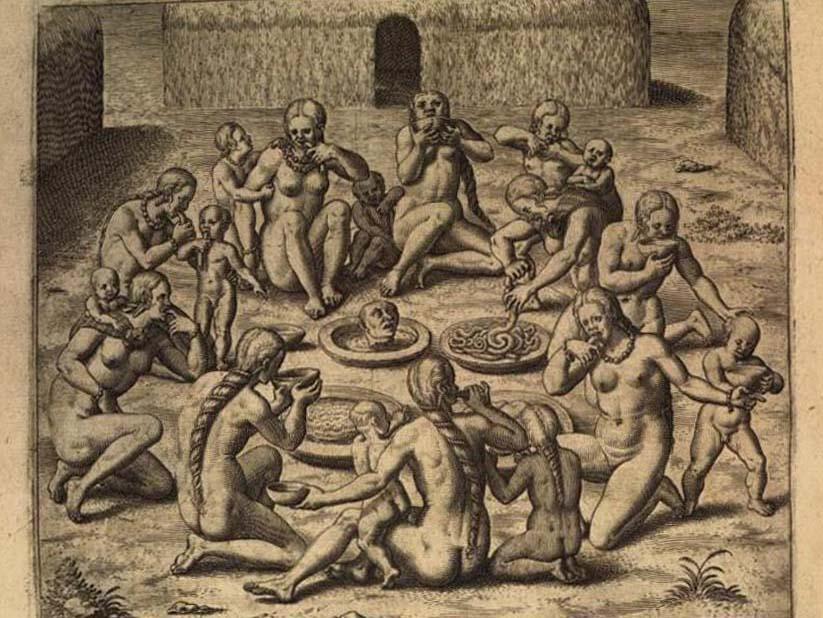Even cannibals observed manners and etiquette when eating human flesh
Cannibalism was never a disorderly activity – cultures that practised it regulated it – and the methods of preparing a person as a meal were many

The very idea of people eating each other is so abhorrent to us that we usually prefer not to think about it. Cannibalism is to us massively taboo, and forbidden with far greater success than is incest. Freud pointed out, as Montaigne had before him, that it is curious we should feel so badly about eating people when we frequently kill them and often sense only gratification for having done so.
The reason derives from the way in which most human beings have categorised their experience. If you can classify people as enemies you may feel you can kill them with justice; but people are not food, and let us keep that straight. Cannibalism is a symbol in our culture of total confusion: a lack of morality, law, and structure; it stands for what is brutish, utterly inhuman. The idea is that, unlike cannibals, we are upright, orderly, enlightened, and generally superior.
But what we might use for symbolic purposes as an embodiment of structureless confusion has nevertheless a basis in clear cold fact: cannibal societies have existed since time immemorial. As social beings, cannibals must inevitably have manners. Whatever we might think to the contrary, rules and regulations always govern cannibal society and cannibal behaviour.
In 1979 it was suggested by W Arens, author of The Man-Eating Myth, that there never has been any such thing as deliberate cannibalism, unprovoked by a threat of starvation; that cannibalism is merely a literary device and a libel against races we wish to cast as “other” than ourselves. But this rather attractive idea – that people have never really eaten each other – has had to be abandoned. We can be sure that cannibalism has been practised in Africa south of the Sahara, in Oceania, America North, Central, and South, in northern Europe, and in the ancient Mediterranean region.
Specialists in Neolithic archaeology have on a number of occasions claimed that the broken bones and cracked skulls discovered at several sites prove that our Stone Age ancestors relished human brains and sucked bone marrow when they could get at it. If they did this, they may well have eaten human flesh too. We are all aware, of course, that in times of desperate hunger people are sometimes driven to eat dead companions in order to save their own lives. If there has been no actual killing of one member of the party in order to provide food for the others, and if the eating has been done with reverence for the solemnity and dire necessity of the action, then even modern people find such an emergency measure understandable and forgivable.

Indeed, we emphasise the singularity of these occurrences with such fervour that we are probably underscoring for ourselves a fundamental law for our culture: that such acts could never become normal. Eating human flesh under extreme duress and treating it as an act which would never otherwise be countenanced is not what I mean here by “cannibalism”.
True cannibalism is publicly approved by the society which practices it and is at least potentially a repeated, and usually a ritual, act. What little we know of the ideas and attitudes of cannibals suggests that they might have done shocking things according to our system of rules, but they did not behave with merely random brutish greed. Hunger was doubtless often a driving force behind the practice; excellent arguments have been made that cannibalism can arise as a society’s response to a lack of protein. But descriptions of cannibals usually insist that they surrounded the eating of human flesh with carefully prescribed ritual.
The great Aztec state fought wars to provide itself with prisoners, who were eventually eaten. Estimates of the number of victims put to death and consumed annually when the Spanish arrived in Mexico in the 16th century range from 15,000 to 250,000; the figures are highly uncertain, but everyone agrees that the numbers were huge.
In 1521, 62 Spanish soldiers, captured in war by the Aztecs, were led in procession to one of the temple-pyramids of the capital, Tenochtitlán, now Mexico City. As Aztec prisoners of war, they were to be violently killed and their beating hearts offered to the god. In The History of the Conquest of New Spain, Bernal Díaz del Castillo, a soldier in Hernán Cortés’s army, describes the scene: “Again there was sounded the dismal drum of [the sun and war god] Huichilobos and many other shells and horns and things like trumpets and the sound of them all was terrifying, and we all looked towards the lofty Cue [temple-pyramid] where they were being sounded, and saw that our comrades whom they had captured when they defeated Cortés were being carried by force up the steps, and they were taking them to be sacrificed. When they got them up to a small square in front of the oratory, where their accursed idols are kept, we saw them place plumes on the heads of many of them and with things like fans in their hands they forced them to dance before Huichilobos, and after they had danced they immediately placed them on their backs on some rather narrow stones which had been prepared as places for sacrifice, and with stone knives they sawed open their chests and drew out their palpitating hearts and offered them to the idols that were there, and they kicked the bodies down the steps, and Indian butchers who were waiting below cut off the arms and feet and flayed the skin off the faces, and prepared it afterwards like glove leather with the beards on, and kept those for the festivals when they celebrated drunken orgies, and the flesh they ate in [the dish] chilmole.”
There are two main types of simple cannibal society: those who eat their own people, especially their relatives; and those who eat only enemies, foreign to their tribe. These two broad categories cover a great variety of behaviour and belief – even given the fact that we know about very few cannibal societies compared with the many that must have existed in the past.
Endo-cannibals (who eat their own) have been described as “cemeteries for their dead”. They may believe, for instance, that a sort of life essence inhabits every human body, that this essence flows via most social activities, including those to do with sex and food, through the community. Members of a tribe can, and indeed must, “take in” the life essence of a dead fellow tribesman by eating him after he has died a natural death. Failure to eat a dead parent might mean poor health, or barrenness, or weak children, since the life essence has not been “topped up” properly by the living members of the tribe. This kind of cannibalism is felt directly to influence plant and animal fertility as well.

Flesh is often not consumed in endocannibalism; people prefer to grind up bones or burn the body to ashes, then eat the powder mixed in a drink or with, say, mashed banana. (Such practices show that eating people is not always for their protein content.) There might also be a taste – culturally induced, we are relieved to remind ourselves, in this particular social constellation – for half-rotted corpse carefully dug up and consumed, or for festering flesh from wounds. The action of eating one’s relatives is often sad, solemn, and loving: it can be a form of mourning ritual. It is also possible, however, for people in these societies to appear quite matter-of-fact, to eat up cheerfully and feel no apparent awe during the process.
Exocannibalism was more common than endocannibalism, more violent and destructive – and easier for us to understand. Here people hate the people they consume, but eating their flesh is a joy. They pursue their victims and eat them for vengeance. Captives were often tortured before being killed, or made to do battle against hopeless odds; it was hoped that, in the process, they would show considerable courage. They would then be eaten with special appreciation, the bravery they had been proven to possess passing into the bodies of their killers.
At the Aztec “gladiatorial” sacrifice, for instance, the captive was tied by the waist to a sort of umbilical cord attached to the centre of the sacrificial stone. He was given weapons, and then attacked by warriors one by one until he fell. When he was seen to be about to die, he was seized, stretched on the stone, and slaughtered. The man who had captured him in battle would take his captive’s blood in “a green bowl with a feathered rim. . . . On the lips of the stone images, on each one, he placed the blood of his captive. He made them taste it with the hollow cane.” The body was flayed so that its skin could be used later as a cloak, and the flesh carved up and eaten. The captor of this man was proud of his victim’s prowess, and identified himself with him and his courage. He would therefore refuse to eat him. “He is my son,” he would say. “Shall I perchance eat my very self? ”
Cannibals themselves often regard the eating of human flesh in general with awe and horror; it is ritually marked off from regular eating. The ancient Fijians, for example, ate everyday meals with their hands. When it came to eating human flesh, and only then, they used a special wooden fork. Cannibals often deny that they started the practice of eating people. The gods may have demanded it; we have no choice. Bloodthirsty enemies beyond our boundaries think of nothing but how to kill and eat us; we must meet force with force, and assure them that they will not eat us without paying exactly the equivalent price. The relationship of a cannibal with his victim may involve an elaborate metaphorical construct: the one to be tortured, killed, and eaten might represent darkness, primitive bestiality, the animal. (This is rather like our own imaginary monsters, who often turn out to be cannibalistic.)

Cannibalism, whatever form it took and for whatever reason, was never, in real life, a disorderly activity within the culture that practised it. The fact that it was allowed, sanctioned, or institutionalised made it a practice that was regulated, even if the rules were occasionally simple. As far as we can tell with our scrappy information, that is, and even if rules were commonly broken, as reporters from some societies say they were. Even when violent aggression reigned, there were social preferences, tastes, and traditions; something almost amounting to a cuisine. Many were the methods of preparing a man as a meal.
The anthropologist Paul Shankman – in the course of examining cannibal cooking practices as a test of Lévi-Strauss’s claims that roasting is high in prestige, boiling low, and so on – collected ways of cooking people culled from reports on cannibal societies. The resulting collection was a “veritable smorgasbord” of methods. People have indeed been boiled in pots, and roasted by spit, rack, or exposure to an open fire. They have also been steam-baked, cooked on preheated rocks and in earth ovens, smoked, decomposed first, dried, powdered, preserved, stuffed into bamboo tubes and placed in the embers, their bones burned to ashes and stirred into many kinds of sauces, juices, and mashes. A body could be buried, then exhumed and eaten in its rotten state.
Here is an account, by Ronald Berndt, of one such meal: “On the afternoon of the sixth day following his death his corpse was exhumed. The maggots were scraped off and placed on banana leaves. The body was then cut up, the meat and bones being cooked in one oven, and the maggots, tied up in small leaf bundles, in another; these are regarded as a delicacy.”
The attention to detail, the neatness, and the decisiveness about what one wanted and how to achieve the necessary effect give this description a weird but unmistakably technological air like that of a careful culinary article from a magazine for gourmets. There were various tortures where people were prepared for cooking while still alive. People were eaten raw at times – but this was quite seldom, and even then there were rules. There was always the matter of who got which piece, and how much of it.
Sometimes women did all the cannibalism (“materialist” anthropologists point out that this would have been because the men ate nearly all the animal meat themselves, leaving the women little protein), and sometimes it was the men, exulting over their prisoners of war by eating them. There were rules, among endo-cannibals, about which relatives one must not, or which one must at all costs, eat. A dying endo-cannibal might catalogue in detail which parts of him or her were later to be eaten by whom: a last will and testament of admirably generous detachment.
Then there were the rituals during cannibal meals. These ranged from matters of simple order – whether or not one should collect the grease falling from cooking limbs, for example, and who had the right to eat it and how – to the extreme formality and richness of Aztec breast-cutting and heart-snatching ceremonies atop their blood-blackened pyramid shrines. Indications are that more ritual usually governed the eating of people than was found necessary at ordinary meals. But every dinner eaten with others requires rules, and these soon become elaborated into a system of table manners, which are ritual where eating is concerned.
Extracted from The Rituals od Dinner: The Origins, Evolution, Eccentricities and Meaning of Table Manners by Margaret Visser. Published by Penguin, £9.99
Join our commenting forum
Join thought-provoking conversations, follow other Independent readers and see their replies
Comments
Bookmark popover
Removed from bookmarks